Beachvolleyball drills
- The group stands on one side behind these hoops.
- When told to do so, the children steal objects from the other side and place them in the hoops on their own side.
- If they are caught by a ticker, they have to put the object back.
- The group is lined up in the four corners of the field.
- A ticker with a party ribbon
- At a signal they cross the field in three directions:
- the short side, the long side or diagonally.
- On their return, they score one, two or three points respectively.
- A ticker operates in the room and forces the ticked children to go back to his corner before he can cross again.
- How many points can you get in an agreed time?
- The first player serves the ball to a certain area in the field.
- The other players must serve to the same area.
- Whoever does not hit the target area gets a letter.
- The first player to collect all the letters of the pre-conceived word has lost the game.
Adjustments
- As long as the ball is within the target area, any type of service will do.
- Increase the distance of the service.
- Start at 5 metres and execute.
- Repeat at 6 metres and so on.
- Especially with younger players.
- If the first player hits the target area with a jump service, the following players must also hit the area with a jump service
- 1 Coach and 3 players are ready.
- The coach serves the ball over the net.
- A player passes, a player sets, a player catches.
- After the completion they turn one spot.
- A variable is to focus on pass and/or set and/or attack.
- The more tasks the players are given, the harder the challenge becomes.
- The simplification of these exercises can be found in having the players perform 'only' one task.
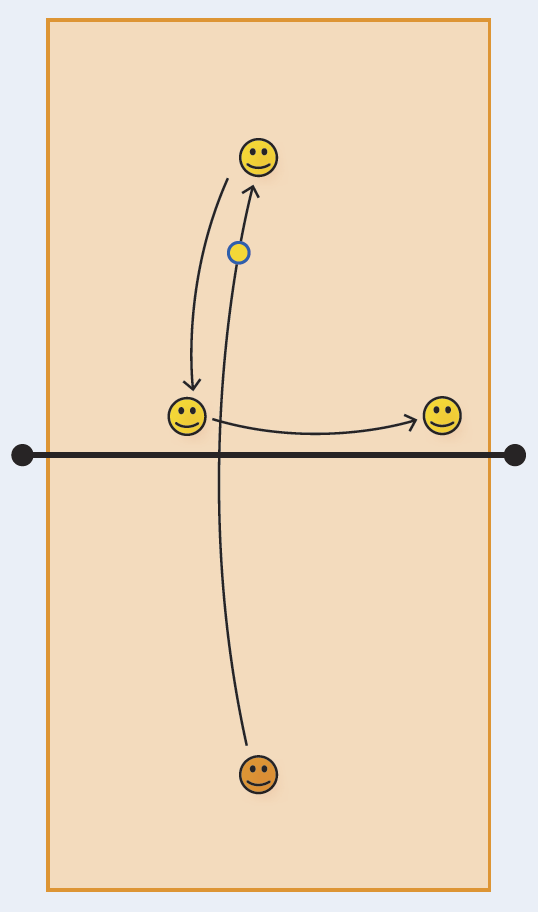
Adjustments
- Throwing the ball in instead of serving.
- Serve from different positions.
- Making serving more difficult.
- Passer and setter run in from different sides.
- Set the ball in a basket.
Objective:
- The goal is to separate the elements and deliver quality.
- Pass the ball to the desired position.
- Then getting into an attacking position, and executing the hitting technique.
- Hereby preparation for the jump and reach is essential.
Execution:
- Two sides of the net are used.
- Player 1 stands at one side of the net, throws up the ball and hits it to player 2, who stands in a service-pass position.
- It is important to use the right technique when hitting the ball.
- Player 2 passes the ball to the trainer.
- Pay attention to the passing to the desired set position.
- The trainer catches the ball and throws it immediately in a perfect setup (start with a 1m set which contains a peak).
- Player 2 gets into position for the attack, and attacks in a specific area (use pawns as targets).
- After the attack, the player advances to the serving position.
- After player 1 hits the ball he joins behind the line of passers/attackers.
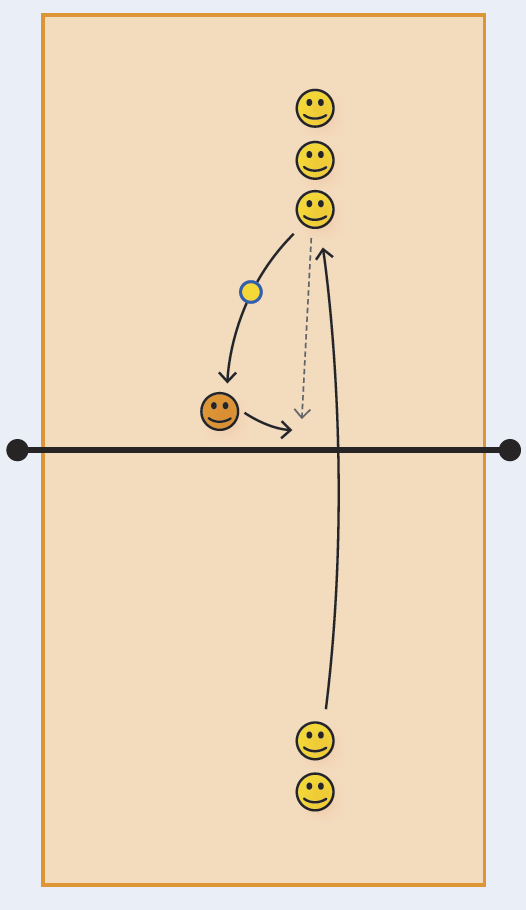
Adjustments
- Initially the direction of attack is "only" right or left.
- As the exercise progresses, the goal can be made smaller and more accurate.
- The ball can also be thrown in instead of hit by player 1.
- Give player 1 a more specific assignment.
- Use the distributor instead of the trainer who catches and throws the ball.
- Make attack zones smaller to increase the precision needed.
- Build up the attack from the service and attack with a defense.
- 1 server, 1 passer, 1 playmaker, 1 finisher.
- Between the passer and the setter an inverted triangle can be visualized.
- The top of the triangle lies near the passer, the bottom against the net.
- Start the exercise with an easier serve.
- The pass should be sent to the corner of the triangle, which is the most middle of the court.
- The setter sets the ball to the other end.
- The distance between them is max 2 meters.
- To work more accurately a standing basket can be used.
- Continuation: Instead of a basket the coach plays the ball back to the passer, repeats and catches / plays out if necessary.
- With 3 players use 1 passer and 2 setters; coach serves.
- With 5 players you let 2 playmakers alternate.
- With 6 players divide the game in two groups and use both sides of the court.
- Work on the correct technique - turning in towards the post, before the set is given, helps with the execution.
- The set should be given in a dynamic movement in the attacker's shoulder line.
- The most common is to work with a standing leg (front leg) in a small lunge position with the legs initiating the set up.
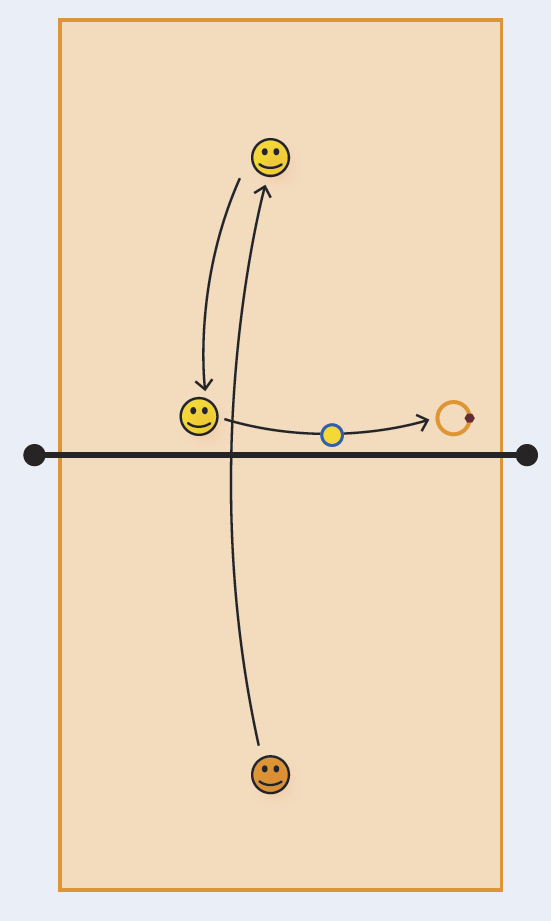
Adjustments
- The service of the 1st ball can be very easy so that the passer can deliver a good pass every time.
- Increase the pass rush by making the service more difficult.
- Have the setter start from a deeper point in the court.
- Have the setter start from block position.
- Vary set goals; increase the distance to the goal or decrease the goal, shift the goal per set.
- Try to get 5 perfect passes and setups in a row.
- Involve the partner in the exercise by giving feedback, or by having the ball attacked without a jump.
- Serve the ball with a different target each time:
- Target 1: A precise area where you want to serve the ball (e.g., put the hoop there)
- Target 2: A wide area where you want to serve the ball
- Goal 3: A limited internal target, e.g. the feel of the ball in your fingers
- Goal 4: A wide internal target, e.g. watching the ball in your hands
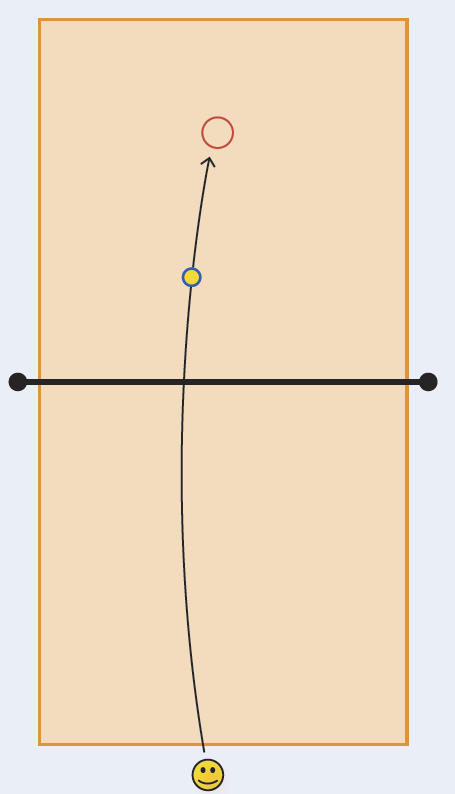
Adjustments
- Creating a smaller target
- Serving from different positions
- Build an attack on one side;
- The blocker stands in front of the attacker, pretends to jump and steps back;
- The attacker plays a short ball over the blocker; the blocker defends the ball and the rally continues or the ball is scored.
- When the attacker gets in the middle, you can train both ways.
- The same when the attacker plays short diagonally
- The blocker makes a step into the diagonal, pretends to jump and then runs to defend the diagonal ball.
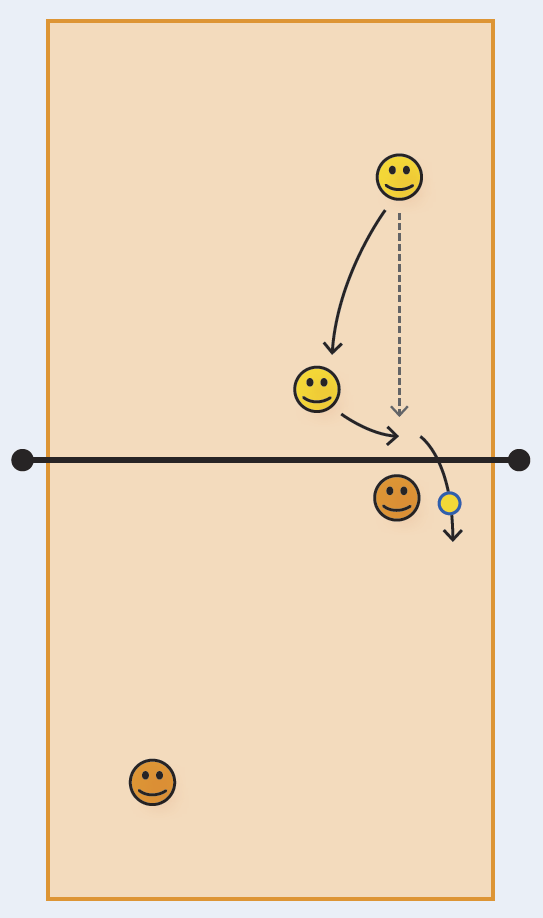
Variations:
- The first ball must be played short.
- Then play against each other for the point.
- Apply it in a situation where the attacker has no restrictions.
- Trainer (or one of the players) throws in the first ball from a table.
- The attacker may try to score the ball in the area just behind the net.
- Along the line or diagonally. With a defender added the








